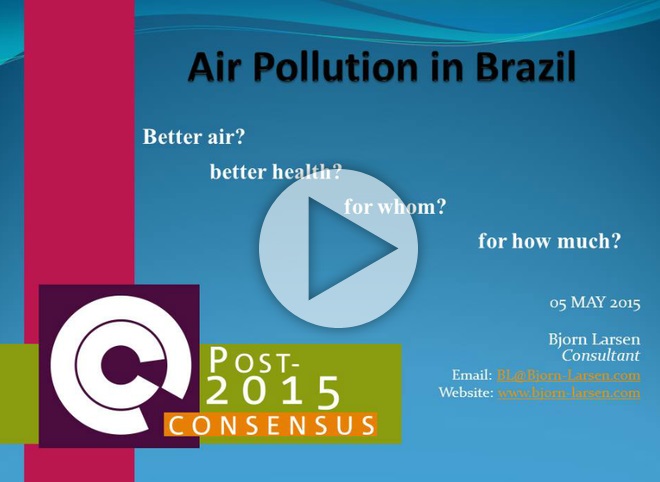Brazil Perspectives: Air Pollution
Background
Air pollution kills about 49,000 Brazilians every year. About half of these deaths – 25,000 – are from the outdoor pollution that we normally worry about, particularly in cities. The other 24,000 result from household air pollution, caused by cooking with wood and other solid fuels. This affects mainly rural communities. Deaths from both outdoor and indoor air pollution represent one in every 26 deaths from all causes in Brazil, making it the ninth largest mortality risk in the country.
In both cities and countryside, the cause is the same: tiny particles in smoke which we breathe in and which can lead to chronic lung disease and acute respiratory infections, lung cancer, heart disease and strokes. This does not just affect Latin America, but is a global problem causing over 6 million deaths worldwide each year.
The most dangerous of the airborne particle are known as PM2.5 (particulates less than 2.5 thousandths of a millimetre across) which can penetrate deep into the lung. The World Health Organization (WHO) has set a limit for average outdoor ambient air pollution of 10 micrograms (millionth of a gram) of PM2.5 per cubic metre of air (10µg/m3). In urban areas, the level may be twice this, for example 22µg/m3 measured recently in Sao Paulo and 7-28µg/m3 in six major cities near busy streets. Overall, about 40% of the Brazilian population is estimated to breathe air which is more polluted than the WHO guidelines.
Generally, air quality in Brazilian cities is reasonably good, although about 7,000 lives could be saved by reducing maximum outdoor PM2.5 exposure to 15µg/m3, the World Health Organization’s third interim target. But reducing indoor air pollution would be a much less expensive way to save as many lives.
19 million Brazilians – about 9.5% of the population – cook primarily with firewood, and many other households use wood as a secondary fuel. For these households, air pollution is often at least ten times higher than in towns and cities. Another 2-3% of the population use charcoal as their primary or secondary cooking fuel. This is less polluting than wood, but households still face substantial pollution.
In Latin America, the person doing the cooking in households using firewood breathes air with an average concentration of PM2.5 of 115-265µg/m3, 11 to 26 times the WHO recommended level. Replacing open fires and traditional stoves with improved, well-maintained cookstoves with chimneys that vent to the outside reduces this exposure by over half.
Doing this in Brazil should reduce average PM2.5 exposure from 180 to 80µg/m3. To make greater improvements, households need to make the transition to the more expensive propane (LPG). If all households in a community used LPG, pollution may decline to 25µg/m3 or less, but exposure would be perhaps double that if only a fraction of households changed.
Adoption of improved cookstoves would reduce PM2.5 exposure by over half and reduce the risk of disease and death by 34%. Going further and using LPG would reduce disease and death by 47-67%, depending on the rate of adoption across the community.
The market for improved cookstoves is underdeveloped in many parts of the country and little has been done to promote them in the last two decades. Countries in the region including Mexico, Peru and Guatemala have successfully marketed biomass stoves with a chimney to vent the smoke[i]. Similar stoves in Brazil, such as the Ecofagao and IDER can cost 500 Reals including installation, but they burn only about half the amount of wood used in traditional stoves, so there are savings on fuel costs. On the other hand LPG stoves can cost 500-600 Reals, and the fuel can cost a further 400 Reals a year.
For both cases, the benefits in health, fuel savings and time more than outweigh the cost. There are benefits worth about 7 Reals for each one spent on improved cookstoves and 2.8 Reals for spending one on LPG stoves (somewhat less if there is still substantial pollution from firewood). Spending to reduce household air pollution gives 2-20 times more benefit per Real than spending money on typical measures to reduce urban ambient air pollution.
Since a full transition to LPG could not happen quickly, a reasonable interim target would be to convert half the households to improved wood-burning cookstoves and the other half to LPG. This would save 7,350 lives a year and reduce the total number of deaths and cases of illness by 41%. Converting fully to LPG would save a further 5,000 lives a year.
[i] Berrueta, V., Edward, R., and Masera, O. 2008. Energy performance of wood-burning cookstoves in Michoacan, Mexico. Renewable Energy, 33(5), 859–870.


